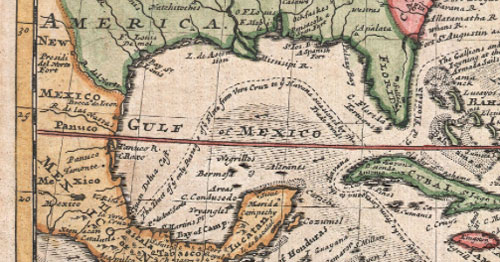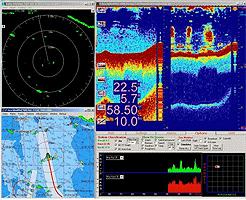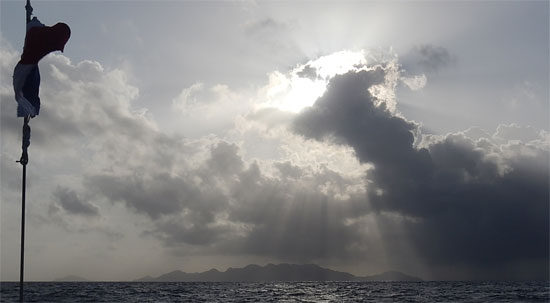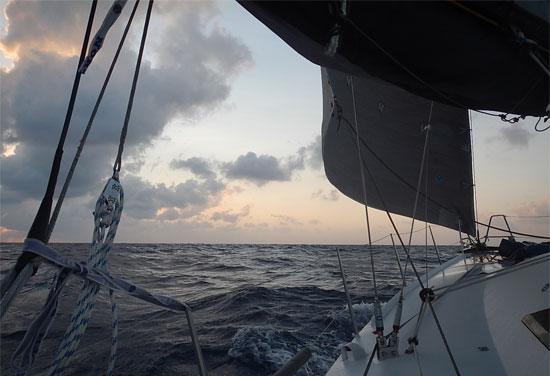Moving along nicely here, coming around the tip of Cuba, sailing across the grain of the trade winds through warm and sunny days. The area I’m passing through, is where the Gulf Stream rises back to the surface and begins driving the currents north around Cuba and east to the Atlantic, up the North American coastline and all the way across to Europe where they cool, sink into a deep level river, flow back down the European coast and return towards the Caribbean … much like a giant conveyor belt. For the past few days, I’ve been feeling this rising current pushing us forward.
Yesterday, Memorial Day was extremely memorable for me in that I was lucky enough to be visited by a huge school of cavorting dolphins! Such encounters always bring a broad smile to my face! These amazing creatures exhibit such constant joy in having this ocean world as their playground.
A Dolphin Stampede! (Here’s another shorter clip.)
Nights out here have been cool, which allows me to relax after long days of avoiding dehydration and sunburn. Sitting out on deck at night, I watch the hazy clouds drift across the sky as I wait for the sliver moon to rise and then hours later, just before daybreak, the morning star. I find this time under the stars is the best time for reflection.
The other night, I began to reflect on the countless voyages before my own that have sailed these same Caribbean waters. 500 years of ships (that we know about)… each one different than Bodacious Dream, yet similar too in that each was voyaging under skies like these and across waters full of the same beauty, danger and promise.

A map of the Caribbean from 1732
I thought about the ships of great navies crossing largely uncharted oceans to militantly lay claim to new lands and to harvest treasures for the coffers of their rulers. I thought about ships full of immigrants, just like my own ancestors, crossing dangerous waters to start new lives in new worlds. I though about centuries of slave ships too. It’s easy to forget that at one time, Galveston, Texas was as busy a port of entry, as Ellis Island in New York would later become.
I thought of how life must have been for such sailors, adventurers, soldiers, immigrants, captives and the various pirates and brigands that plied these waters too. I recall a story from Panama of a solid gold altar and bell of a church, both painted black to hide them from the pirates. The altar was later rediscovered and restored, but the location of the bell remains a mystery… another hidden treasure that continues to stir people’s imaginations today.
When an island of Providence (pictured above) pops out of the early morning haze, it’s easy to assume that things don’t change quickly out here… but of course we know now that they do – evermore quickly and in many cases, irreversibly.

Today’s ships are almost all technologically enabled with all kinds of fancy electronics. Such advancements quickly change old ways of doing things… sometimes with unexpected consequences. For example, they have helped increase the yields on fishing such that we now face the prospect of a world of depleted fish. Is it is even possible that the stocks of the world’s fish will ever be restored back to sustainable levels?
On this voyage, I learned of fishing operations where cameras on underwater nets give operators working in front of screens the ability to remotely manipulate their nets to greatly increase their ability to capture an entire school of fish in one pass!
It’s amazing how in a few short years the equilibrium between humans and nature’s once abundant resources have tipped dramatically, largely owing to these escalating powers that new technologies have made possible.
While it’s fun to drift off into thoughts of the past, one quick glance at my AIS radar screen brings me back to the present and to the view it provides me of FIVE cargo ships in my vicinity, variously heading north to the Atlantic or south to Panama… and from there to points unknown.
All these technological advances… are now just part of our lives. They’re just the latest by-products of restless and ambitious human ingenuity. While we must seek out ways to better balance how we use these technologies, such that we avoid eliminating natural resources essential for our mutual survival, we also cannot turn back progress either.
What we can do is be clear that our increased capacities come with responsibilities to enlighten and to improve our world – and not simply to exploit it. I think a big part of such a pact with the future has to do with directly sharing what we each have learned and experienced with those younger than us.
In a coming update, I will share some amazing learnings that I was able to extract in the process of interviewing several old friends and colleagues of mine… each of whom is an expert in some technologically augmented field of sailing.
- On navigation technology, I interview John Hoskins and Matt Scharl.
- To learn about new rigging technology, I interview Alan Veenstra.
- And finally, I had the great good fortune to interview the lead builder of Bodacious Dream, Lapo Ancillotti on new composite materials technology used in modern boat-building.

New techniques in navigation, rigging and composite materials …
I may not have an answer to the larger environmental challenges that we face today, but I do know that any knowledge is a form of power… and as such, it is most useful when it is shared. I have always felt that way about whatever insights have been mine to share … and I am especially looking forward to sharing with all of you, some of what these great and talented seamen have learned as well.
Well, enough for now … more adventures await me today, back to sailing and looking out across vast horizons of possibilities.
– Dave, Bodacious Dream (and the ever-curious) Franklin




